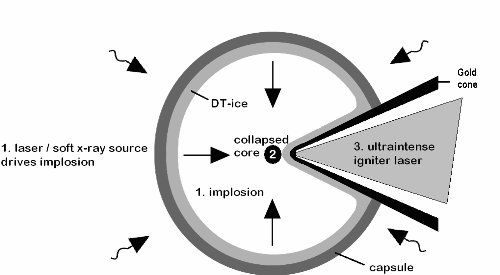Fast Ignition
What is fast ignition?
Contact person: John Pasley and Kate Lancaster
Fast Ignition is a special approach to Laser Fusion in which the energy to heat the fuel come from a separate laser, rather than from the implosion process. This allows for the fuel to be heated more efficiently. It is quite inefficient to heat fuel by the process of implosion. There are a number of approaches to Fast Ignition that are under current study. The one that we are primarily involved in investigating is that known as ‘Re-entrant cone guided fast ignition’. In this approach a small gold cone is imbedded into the side of the spherical fuel capsule, providing a clear pathway to the central region where the compressed fuel globule is formed.
The ultra-intense laser that ignites the fuel is fired into the cone. Where it interacts with the cone tip an enormous number of extremely energetic electrons are generated. These electrons fly out into the fuel, heating it to the temperatures required for fusion.

Re-entrant Cone Guided Fast Ignition is a 3 step process. The implosion is driven by soft X-ray or laser radiation (1). A dense fuel globule is formed at the tip of the cone (2). Finally an ultra-intense igniter laser injects energetic electrons into the fuel, heating it to the conditions required for fusion (3).
References
M. Tabak et al, Review of progress in Fast Ignition, Physics of Plasmas 12, 057305 (2005)
